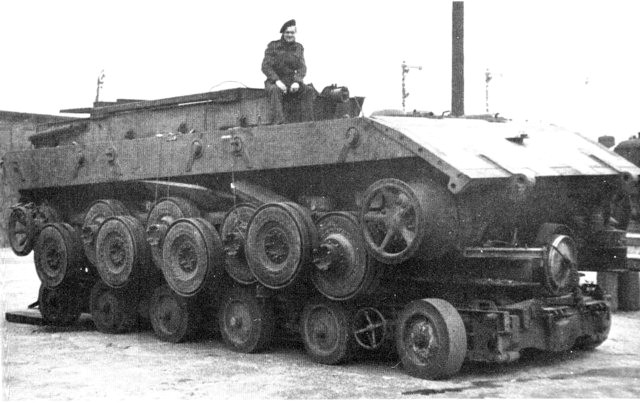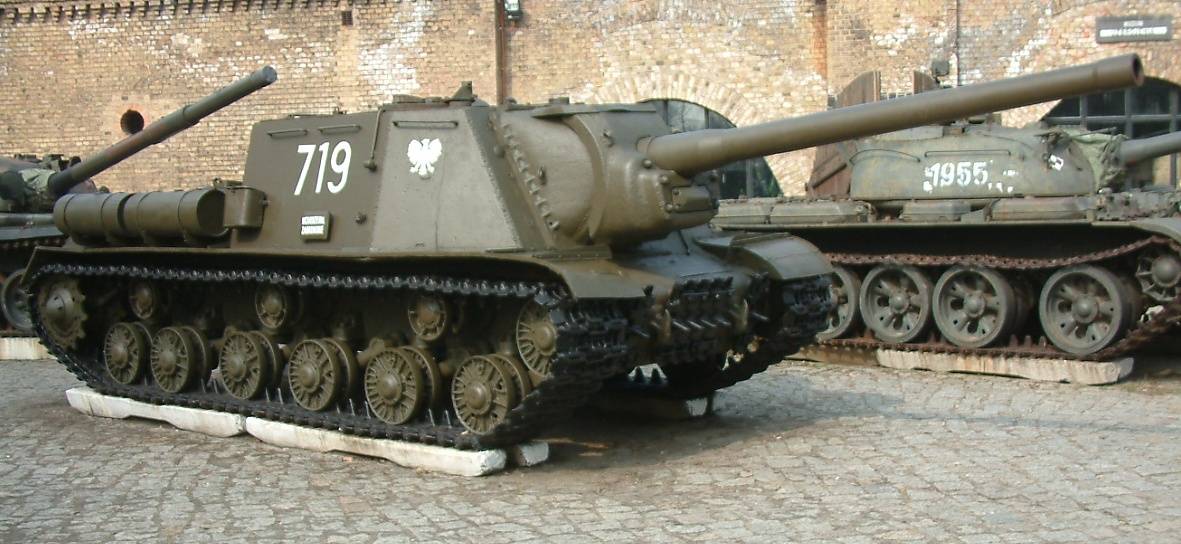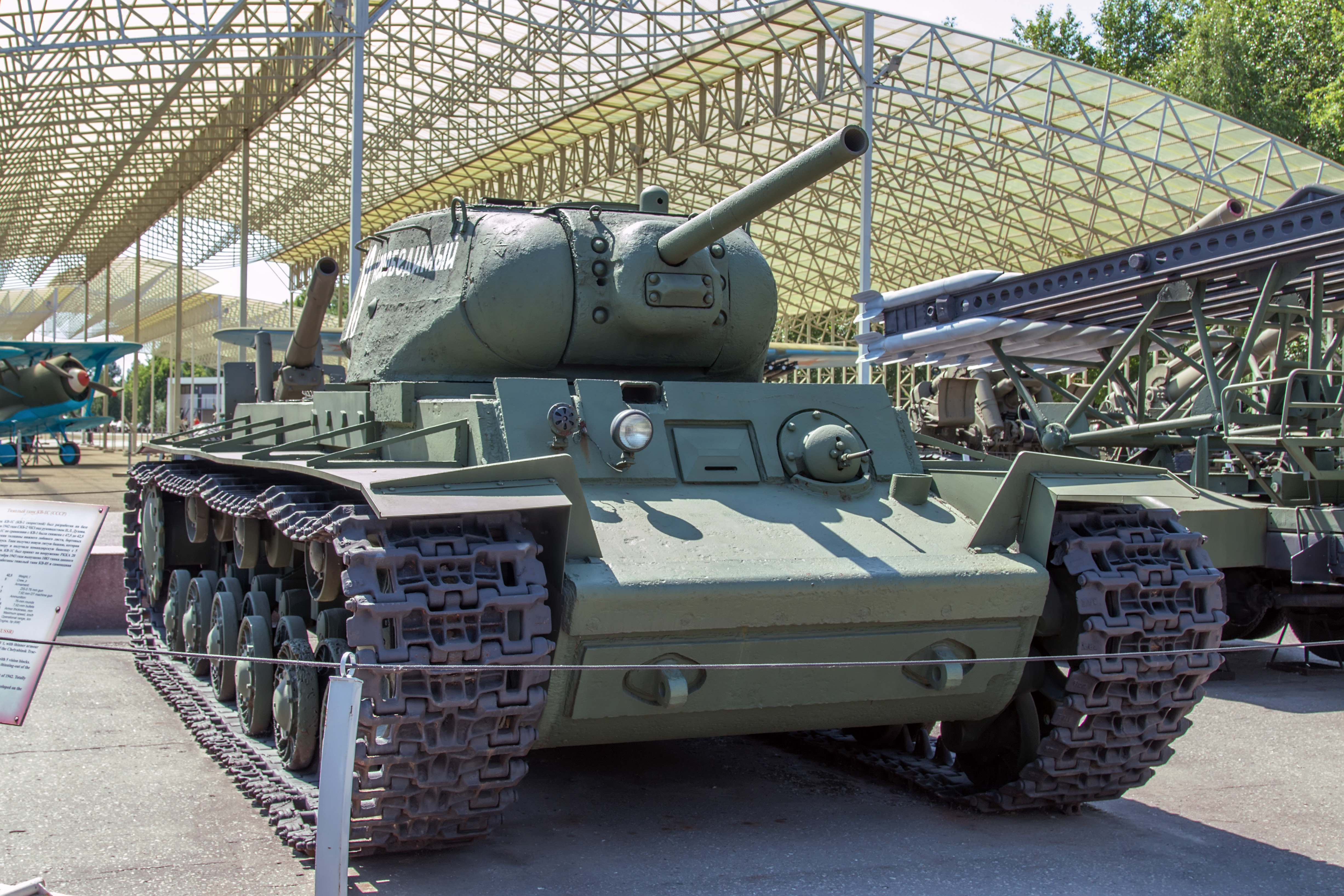|
IS-7
The IS-7 heavy tank, also known by its project name Object 260, is a Soviet tank that began development in 1945. The vehicle existed only in prototype form and was cancelled in favor of the T-10 tank. Design and production The IS-7 heavy tank design began in Leningrad in 1945 by Nikolai Fedorovich Shashmurin Weighing 68 tonnes, thickly armoured and armed with a 130 mm S-70 long-barrelled gun, it was the largest and heaviest member of the IS family and one of the most advanced heavy tank designs. The armour was engineered in a similar fashion to the IS-3, with a pike nose on the upper glacis sporting 150mm of armor sloped at 65°. This armor was designed to defeat rounds from the Jagdtiger's 12.8 cm Pak 44 from as close as . The lower glacis was designed to be 100mm but a measure taken by Nicholas Moran found it to be as thick as 110-120mm depending on welding variations. The armor on the sides was also 150mm on the upper side plate and 100mm on the lower side plate. B ... [...More Info...] [...Related Items...] OR: [Wikipedia] [Google] [Baidu] |
IS Tank Family
The IS tanks (russian: ИС) were a series of heavy tanks developed as a successor to the KV-series by the Soviet Union during World War II. The IS acronym is the anglicized initialism of Joseph Stalin (, '). The heavy tanks were designed as a response to the capture of a German Tiger I in 1943. They were mainly designed as breakthrough tanks, firing a heavy high-explosive shell that was useful against entrenchments and bunkers. The IS-2 went into service in April 1944 and was used as a spearhead by the Red Army in the final stage of the Battle of Berlin. The IS-3 served on the Chinese-Soviet border, the Hungarian Revolution, the Prague Spring and on both sides of the Six-Day War. The series eventually culminated in the T-10 heavy tank. Design and production KV-85 IS-85/IS-122 and IS-2 The KV-85 heavy tank was a modification of the KV-1S heavy tank. The tank was a result of the USSR's tank design bureau being torn in two, one half focusing on the KV-85 and its variants, ... [...More Info...] [...Related Items...] OR: [Wikipedia] [Google] [Baidu] |
List Of Soviet Tanks
Below is a list of tanks and other armoured fighting vehicles of the Russian empire, Soviet Union, the Russian Federation, and Ukraine. Imperial Russia, World War I Armored tractors *Gulkevich's armored tractor *F. Blinov armored tractor *Walter armored vehicle Tanks *Vezdekhod *Vezdekhod No.2 *Tsar tank *Mendeleev Tank (project) *Rybinsk tank *Earth Battleship (''Земной броненосец'') - project Self-propelled guns *Drizhenko self-propelled gun *Turtle (Navrotsky Self-propelled gun) After World War I to early World War II (1918-1940) Armored cars * FAI armoured car, FAI * FAI-2 *''Broneavtomobil''-series armored cars: ** BA-I ** BA-3 ** BA-5 ** BA-6 ** BA-6S - half-tracked version of BA-6 ** BA-9 ** BA-10 ** BA-11 ** BA-20 ** BA-21 ** BA-23 ** BA-27 ** BA-30 * BAD-1 * BAD-2 * BDT * BKhM-1000/800 * D-8 Armored Car * D-9 * D-12 * D-13 * D-18/37 * DSh * DTR * FVV * GAZ-TK * KS-18 * PB-4 * PB-7 * ''Matval Tankettes *T-17 tank, T-17 -3 built *T-21 *T-23 T ... [...More Info...] [...Related Items...] OR: [Wikipedia] [Google] [Baidu] |
Panzerkampfwagen E-100
The ''Panzerkampfwagen'' E-100 (Gerät 383) (TG-01) was a German super-heavy tank design developed towards the end of World War II. The largest of the ''Entwicklung'' series of tank designs intended to improve German armored vehicle production through standardization on cheaper, simpler to build vehicles. By the end of the war, the chassis of the prototype E-100 had been partially completed; it was shipped to the United Kingdom for trials, but was later scrapped. Development The basic design was ordered by the ''Waffenamt'' as a parallel development to the Porsche ''Maus'' in June 1943. It was the heaviest of the ''Entwicklung'' (E) series of vehicles, meant to standardize as many components as possible, in the 100 ton weight class; other designs were the E-10, E-25, E-50, E-75. In March 1944, the Adler company in Frankfurt submitted blueprint 021A38300 for a super-heavy tank called E-100, after the tank was proposed in April 1943 along with the other ''Entwicklung'' serie ... [...More Info...] [...Related Items...] OR: [Wikipedia] [Google] [Baidu] |
Leningrad
Saint Petersburg ( rus, links=no, Санкт-Петербург, a=Ru-Sankt Peterburg Leningrad Petrograd Piter.ogg, r=Sankt-Peterburg, p=ˈsankt pʲɪtʲɪrˈburk), formerly known as Petrograd (1914–1924) and later Leningrad (1924–1991), is the second-largest city in Russia. It is situated on the Neva River, at the head of the Gulf of Finland on the Baltic Sea, with a population of roughly 5.4 million residents. Saint Petersburg is the fourth-most populous city in Europe after Istanbul, Moscow and London, the most populous city on the Baltic Sea, and the world's northernmost city of more than 1 million residents. As Russia's Imperial capital, and a historically strategic port, it is governed as a federal city. The city was founded by Tsar Peter the Great on 27 May 1703 on the site of a captured Swedish fortress, and was named after apostle Saint Peter. In Russia, Saint Petersburg is historically and culturally associated with ... [...More Info...] [...Related Items...] OR: [Wikipedia] [Google] [Baidu] |
ISU-122
The ISU-122 (acronym of'' Istrebitelnaja - or Iosif Stalin-based - Samokhodnaya Ustanovka 122'') was a Soviet assault gun used during World War II, mostly in the anti-tank role. History and purpose A prototype of the ISU-122 (in Russian ИСУ-122) heavy self-propelled gun was built at the Chelyabinsk Kirov Plant (''Chelyabinskiy Kirovskiy Zavod (ChKZ)'', Chelyabinsk, Russia), in December 1943. The design shared the chassis of the ISU-152 self-propelled gun and differed only in armament, having an A-19S 122-mm gun as its main weapon instead of the ISU-152's ML-20S gun-howitzer. Towed versions of these guns used the same carriage: 52-L-504A (Russian designation 52-Л-504А), so installation of an A-19 instead of an ML-20 gun was not a difficult task. After completing development of the ISU-152, ChKZ engineers mounted the A-19 gun on the ISU-152 chassis to create ''"Object 242"'' — the first ISU-122 prototype. It was successfully tested, but not immediately launched into mass p ... [...More Info...] [...Related Items...] OR: [Wikipedia] [Google] [Baidu] |
ISU-152
The ISU-152 (russian: Самоходная установка на базе танка ИС с орудием калибра 152мм, ИСУ-152, Samokhodnaya Ustanovka na baze tanka IS s orudiyem kalibra 152mm, meaning " IS tank based self-propelled installation with 152mm caliber gun") is a Soviet self-propelled gun developed and used during World War II. It was unofficially nicknamed ''zveroboy'' (russian: Зверобой; "beast killer") in response to several large German tanks and guns coming into service, including Tigers and Panthers. Since the ISU-152's gun was mounted in a casemate, aiming it was awkward, and had to be done by repositioning the entire vehicle using the tracks. Therefore, it was used as mobile artillery to support more mobile infantry and armor attacks. It continued service into the 1970s and was used in several campaigns and countries. History The beginnings of the ISU-152 came on 24 January 1943, when the first prototype of the SU-152 was unveiled. Th ... [...More Info...] [...Related Items...] OR: [Wikipedia] [Google] [Baidu] |
Kliment Voroshilov Tank
The Kliment Voroshilov (KV) tanks are a series of Soviet heavy tanks named after the Soviet defence commissar and politician Kliment Voroshilov who operated with the Red Army during World War II. The KV tanks were known for their heavy armour protection during the early stages of the war, especially during the first year of the German invasion of the Soviet Union. In certain situations, even a single KV-1 or KV-2 supported by infantry could halt German formations. The German ''Wehrmacht'' at that time rarely deployed its tanks against KVs, as their own armament was too poor to deal with the "''Russischer Koloss''" – "Russian Colossus". The KV tanks were practically immune to the 3.7 cm KwK 36 and howitzer-like, short-barreled 7.5 cm KwK 37 guns mounted, respectively, on the early Panzer III and Panzer IV tanks fielded by the invading German forces. Until the Germans developed more effective guns, the KV-1 was invulnerable to almost any German weapon except the 8.8 cm Flak gun. ... [...More Info...] [...Related Items...] OR: [Wikipedia] [Google] [Baidu] |
Volute Spring
A volute spring, also known as a conical spring, is a compression spring in the form of a cone (somewhat like the classical volute decorative architectural ornament). Under compression, the coils slide past each other, thus enabling the spring to be compressed to a very short length in comparison with what would be possible with a more conventional helical spring. There are two typical types of volute spring: *The first has a shape for the initial spring steel (or other material for the wound spring) as a "V", with one end wider than the other *The second is the double volute, having two "V" shapes facing away from each other, which forms a distorted cylinder having a wider diameter at the centre than at the ends, forming symmetric attachment points Double volute springs can frequently be found as a component of garden pruning shears. Short posts anchored in each side of the handles, and inserted into each narrow end of the spring, keep the spring in position. However, the applic ... [...More Info...] [...Related Items...] OR: [Wikipedia] [Google] [Baidu] |
Armor Piercing
Armour-piercing ammunition (AP) is a type of projectile designed to penetrate either body armour or vehicle armour. From the 1860s to 1950s, a major application of armour-piercing projectiles was to defeat the thick armour carried on many warships and cause damage to their lightly-armoured interiors. From the 1920s onwards, armour-piercing weapons were required for anti-tank warfare. AP rounds smaller than 20 mm are intended for lightly-armoured targets such as body armour, bulletproof glass, and lightly-armoured vehicles. As tank armour improved during World War II, anti-vehicle rounds began to use a smaller but dense penetrating body within a larger shell, firing at very high muzzle velocity. Modern penetrators are long rods of dense material like tungsten or depleted uranium (DU) that further improve the terminal ballistics. History The late 1850s saw the development of the ironclad warship, which carried wrought iron armour of considerable thickness. This armour w ... [...More Info...] [...Related Items...] OR: [Wikipedia] [Google] [Baidu] |
Jagdtiger
The ''Jagdtiger'' ("Hunting Tiger"; officially designated ''Panzerjäger Tiger Ausf. B'') is a German casemate-type heavy tank destroyer (''Jagdpanzer'') of World War II. It was built upon the slightly lengthened chassis of a Tiger II. Its ordnance inventory designation was Sd.Kfz. 186. The 71-tonne ''Jagdtiger'' was the heaviest armored fighting vehicle (AFV) used operationally by any nation in WWII and the heaviest combat vehicle of any type to be produced during the conflict. it was armed with a 128 mm Pak 44 L/55 main gun which could out-range and defeat any AFV fielded by the Allied forces. It saw brief service in small numbers from late 1944 until the end of the war on both the Western and Eastern Front. Although 150 were ordered, only around 80 were produced. Due to an excessive weight and an underpowered drivetrain system, the ''Jagdtiger'' was plagued with mobility and mechanical problems. Three ''Jagdtigers'' survive in museums. Development With the success of t ... [...More Info...] [...Related Items...] OR: [Wikipedia] [Google] [Baidu] |
Tonne
The tonne ( or ; symbol: t) is a unit of mass equal to 1000 kilograms. It is a non-SI unit accepted for use with SI. It is also referred to as a metric ton to distinguish it from the non-metric units of the short ton ( United States customary units), and the long ton ( British imperial units). It is equivalent to approximately 2204.6 pounds, 1.102 short tons, and 0.984 long tons. The official SI unit is the megagram (symbol: Mg), a less common way to express the same mass. Symbol and abbreviations The BIPM symbol for the tonne is t, adopted at the same time as the unit in 1879.Table 6 . BIPM. Retrieved on 2011-07-10. Its use is also official for the metric ton in the United States, having been adopted by the United States |
Kubinka Tank Museum
The Kubinka Tank Museum (Центральный музей бронетанкового вооружения и техники - Tsentral'nyy Muzey Bronetankovogo Vooruzheniya I Tekhniki -Central Museum of Armored Arms and Technology) is a large military museum in Kubinka, Odintsovsky District, Moscow Oblast, Russia where tanks, armoured fighting vehicles (AFVs) and their relevant information are displayed and showcased. The museum consists of open-air and indoor permanent exhibitions of many famous tanks and armored vehicles from throughout the 20th and 21st centuries (between 1917 and the present day). It also houses and displays many unique, unusual and one-of-a-kind military vehicles of which there are very few remaining examples, such as the German Panzer VIII Maus super-heavy tank, Troyanov's Object 279 Kotin heavy tank, the Karl-Gerät heavy self-propelled artillery, and the Object 120 Su-152 "Taran" tank destroyer, amongst other single or limited-production prototypes f ... [...More Info...] [...Related Items...] OR: [Wikipedia] [Google] [Baidu] |







